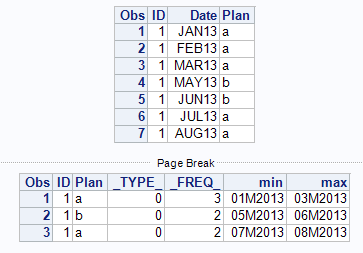- Home
- /
- Programming
- /
- SAS Procedures
- /
- OUTPUT
- RSS Feed
- Mark Topic as New
- Mark Topic as Read
- Float this Topic for Current User
- Bookmark
- Subscribe
- Mute
- Printer Friendly Page
- Mark as New
- Bookmark
- Subscribe
- Mute
- RSS Feed
- Permalink
- Report Inappropriate Content
Hello All,
I was trying to create an output for the dataset
ID Date Plan
1 jan2013 a
1 feb2013 a
1 mar2013 a
1 may2013 b
1 jun2013 b
1 jul2013 a
1 aug2013 a
the output i'm looking to get is ID Plan Date_range
1 a 1-3
2 b 5-6
3 a 7-8
Thanks. Looking forward to some responses.
Accepted Solutions
- Mark as New
- Bookmark
- Subscribe
- Mute
- RSS Feed
- Permalink
- Report Inappropriate Content
You can format the min and max into date range yourself right?
input ID Date:monyy. Plan :$1.;
format date monyy.;
cards;
1 jan2013 a
1 feb2013 a
1 mar2013 a
1 may2013 b
1 jun2013 b
1 jul2013 a
1 aug2013 a
;;;;
run;
proc print;
run;
proc summary data=date nway;
by id plan notsorted;
format date mmyy.;
output out=range min(date)=min max(date)=max;
run;
proc print;
run;

- Mark as New
- Bookmark
- Subscribe
- Mute
- RSS Feed
- Permalink
- Report Inappropriate Content
You can format the min and max into date range yourself right?
input ID Date:monyy. Plan :$1.;
format date monyy.;
cards;
1 jan2013 a
1 feb2013 a
1 mar2013 a
1 may2013 b
1 jun2013 b
1 jul2013 a
1 aug2013 a
;;;;
run;
proc print;
run;
proc summary data=date nway;
by id plan notsorted;
format date mmyy.;
output out=range min(date)=min max(date)=max;
run;
proc print;
run;

- Mark as New
- Bookmark
- Subscribe
- Mute
- RSS Feed
- Permalink
- Report Inappropriate Content
Thank you so much for the help.
Don't miss out on SAS Innovate - Register now for the FREE Livestream!
Can't make it to Vegas? No problem! Watch our general sessions LIVE or on-demand starting April 17th. Hear from SAS execs, best-selling author Adam Grant, Hot Ones host Sean Evans, top tech journalist Kara Swisher, AI expert Cassie Kozyrkov, and the mind-blowing dance crew iLuminate! Plus, get access to over 20 breakout sessions.
Learn the difference between classical and Bayesian statistical approaches and see a few PROC examples to perform Bayesian analysis in this video.
Find more tutorials on the SAS Users YouTube channel.
 Click image to register for webinar
Click image to register for webinar
Classroom Training Available!
Select SAS Training centers are offering in-person courses. View upcoming courses for:



